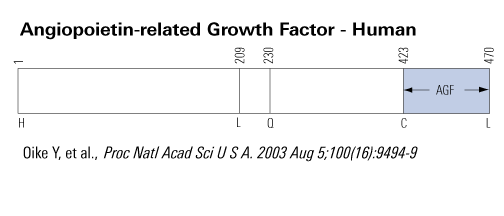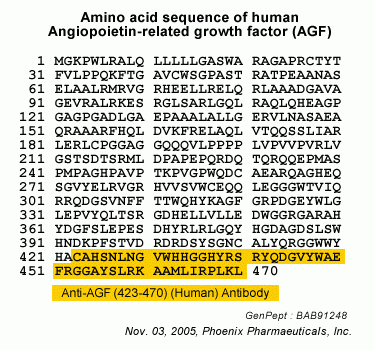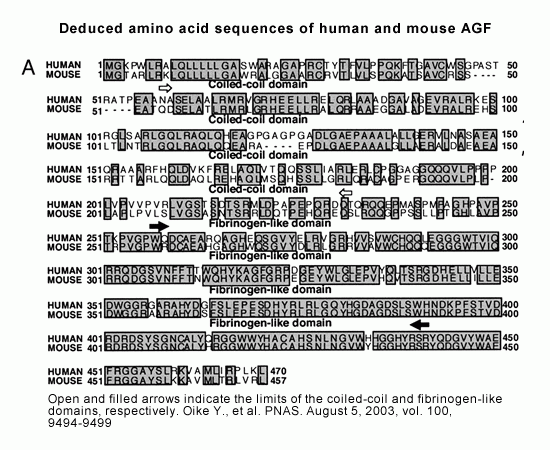


Angiopoietin-related growth factor (AGF), a member of the angiopoietin-like protein (Angptl) family, is secreted predominantly from the liver into the systemic circulation. Here, we show that most (>80%) of the AGF-deficient mice die at about embryonic day 13, whereas the surviving AGF-deficient mice develop marked obesity, lipid accumulation in skeletal muscle and liver, and insulin resistance accompanied by reduced energy expenditure relative to controls. In parallel, mice with targeted activation of AGF show leanness and increased insulin sensitivity resulting from increased energy expenditure. They are also protected from high-fat diet-induced obesity, insulin resistance and nonadipose tissue steatosis. Hepatic overexpression of AGF by adenoviral transduction, which leads to an approximately 2.5-fold increase in serum AGF concentrations, results in a significant (P < 0.01) body weight loss and increases insulin sensitivity in mice fed a high-fat diet. This study establishes AGF as a new hepatocyte-derived circulating factor that counteracts obesity and related insulin resistance.
Oike Y, Akao M, Yasunaga K, et al. Angiopoietin-related growth factor antagonizes obesity and insulin resistance. Nat Med. 2005;11(4):400-8.
We report here the identification of angiopoietin-related growth factor (AGF) as a positive mediator for angiogenesis. To investigate the biologic function of AGF in angiogenesis, we analyzed the vasculature in the dermis of transgenic mice expressing AGF in mouse epidermal keratinocytes (K14-AGF). K14-AGF transgenic mice were grossly red, especially in the ears and snout, suggesting that hypervascularization had occurred in their skin. Histologic examination of ear skin from K14-AGF transgenic mice revealed increased numbers of microvessels in the dermis, whereas the expression of several angiogenic factors, such as basic fibroblast growth factor (bFGF), vascular endothelial growth factors (VEGFs), and angiopoietin-1 (Ang-1), was decreased. We showed that AGF is a secreted protein and does not bind to tyrosine kinase with immunoglobulin and EGF-homology domain (Tie1) or Tie2 receptors. An in vitro chamber assay revealed that AGF directly promotes chemotactic activity of vascular endothelial cells. Both mouse corneal and matrigel plug assays showed that AGF induces neovascularization in vivo. Furthermore, we found that plasma leakage occurred after direct injection of AGF into the mouse dermis, suggesting that AGF directly induces a permeability change in the local vasculature. On the basis of these observations, we propose that AGF is a novel angiogenic factor and that handling of its biologic functions could lead to novel therapeutic strategies for control of angiogenesis.
Oike Y, Ito Y, Maekawa H, et al. Angiopoietin-related growth factor (AGF) promotes angiogenesis. Blood. 2004;103(10):3760-5.
We report here the identification of an angiopoietin-related growth factor (AGF). To examine the biological function of AGF in vivo, we created transgenic mice expressing AGF in epidermal keratinocytes (K14-AGF). K14-AGF mice exhibited swollen and reddish ears, nose and eyelids. Histological analyses of K14-AGF mice revealed significantly thickened epidermis and a marked increase in proliferating epidermal cells as well as vascular cells in the skin compared with nontransgenic controls. In addition, we found rapid wound closure in the healing process and an unusual closure of holes punched in the ears of K14-AGF mice. Furthermore, we observed that AGF is expressed in platelets and mast cells, and detected at wounded skin, whereas there was no expression of AGF detected in normal skin tissues, suggesting that AGF derived from these infiltrated cells affects epidermal proliferation and thereby plays a role in the wound healing process. These findings demonstrate that biological functions of AGF in epidermal keratinocytes could lead to novel therapeutic strategies for wound care and epidermal regenerative medicine.
Oike Y, Yasunaga K, Ito Y, et al. Angiopoietin-related growth factor (AGF) promotes epidermal proliferation, remodeling, and regeneration. Proc Natl Acad Sci USA. 2003;100(16):9494-9.
Social Network Confirmation